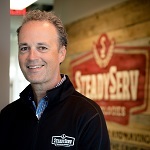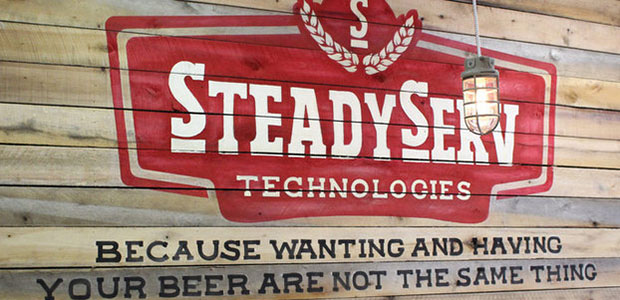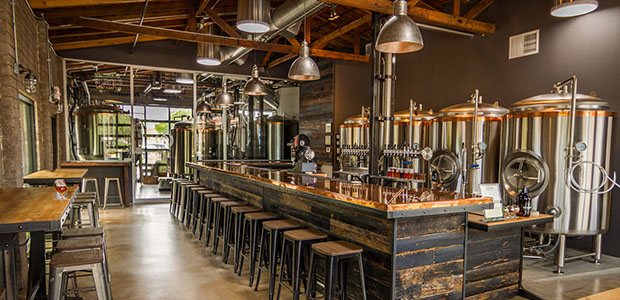* – This article has been archived and is no longer updated by our editorial team –
Is there a ‘New Normal’ looming on the horizon for how food and beverage decisions are made? Below is our recent interview with Steve Hershberger, Co-founder, Chairman & CEO at SteadyServ:

Q: Could you provide our readers with a brief introduction to SteadyServ Technologies? iKeg technology is a huge part of the SteadyServ system. How does it work?
A: The mission of SteadyServ is to provide a clear understanding of the best decision options available for retailers and suppliers to grow beverage sales and profitability.
Today’s retail environment is a chaotic and rapidly changing environment in which competition and costs are increasing at an astounding rate.
Consumers and what they expect shifting faster than retailers are used to. Because of this some are beginning to use smarter digital tools to capture the maximum share of wallet of a consumer. However, new product offerings and blurring product categories continue to expand unchecked. Clear product choices which drive profitability and consumer loyalty are becoming harder and harder to identify, especially since available shelf and tap space remains relatively static.
We focus on paying close attention to product attributes and characteristics. It is these characteristics, not just the brand, that drive popularity and consumption.
Think of it this way. A consumer likes a certain malty, mildly hoppy beer with a slight chocolate flavor and a high alcohol content. When they see something like this on tap, they gravitate to it. The brand that brews their favorite beer is available, but not the product they like. The consumer gravitates to the product characteristics and ignores the brand. They won’t switch products (i.e. ‘flavors’) in order to stick with the brand. Ten years ago, when there were far fewer flavor options brands had more power. Today, the opposite is true for many consumers.
Surprisingly, within the on-premise retail space, which is defined as bars, restaurants, pubs, sporting and entertainment venues, etc., what is made available for sale and its relative popularity is largely managed by guess work, intuition, gut instinct and controlled by personal biases and beliefs. This is a highly inefficient approach.
Now think about what this means to you. Say that you have friends coming over in an hour to watch the big game and you notice that you are out of your favorite beer. You remember you have an ad with a coupon on your desk you saw over the weekend. You grab it, hop in the car and zoom off on a supply run. You drive 15 minutes to a nearby Super Target. When you get to the beer isle, all you see are 24 pack cases of canned beer. Light beer. Mexican Import beer. Domestic Lagers. Your favorite IPA is nowhere to be found. You ask an associate who dully informs you they quit carrying it a month ago. You point to the ad and the coupon and the associate shrugs his shoulders and suggests you just buy something else. After all, you are already here. What’s the big deal? This seems like a crazy example, right? Sadly, it happens every day in on-premise retail. It’s the rule rather than the exception.
When a consumer’s beverage of choice isn’t available at an on-premise retailer, they consume 1/3 less. Furthermore, 79% of patrons whose expectations are not met do not return. Think about the Target example. Would you buy the same amount of a product that doesn’t excite you? Would you go back there to purchase beer next week given this experience? Probably not. We don’t accept this kind of experience in a big box retailer, so why do we accept it in on-premise?
Given these facts and statistics, why would any retailer not take the steps necessary to fix the problem? Interestingly, retailers are obsessive about food waste and making sure they have what is on the menu. You have never gone three items deep on a menue trying to order an entrée. Can you imagine hearing “nope” or “sorry, out of that too”, or ‘try again, we stopped carrying that last week” when ordering your dinner?
Knowing that alcoholic beverage generates 5x more margin than food, so why does this happen? Because there have been no better options for retailers to manage beverage other than to rely on the people who sell to them to provide guidance (and they are guessing), as well as, rely on experience and gut instinct. It’s not their fault. The tools just haven’t existed until recently. Enter AI and SteadyServ.
AI and machine learning-driven retail intelligence is quickly becoming critically important to a retailer’s success and that is exactly what we deliver. The retail space is in tremendous flux right now. There are more products fighting for static space in on-premise and C-stores. Amazon has off-premise big box and suppliers rattled and Millennials have taken over as the most influential CPG purchasers and they don’t act like any customer segment seen any time before.
Analog retails who have relied on gut instinct and experience for years are getting creamed. Revenue for many is down 5-9% from last year. Distributors are also spooked and are forced to carry more products than ever before and contend with (gasp) a growing body of very real competition for the retailer’s business. It is going to get worse before it gets better.
As Sun Tzu once said, “In the midst of chaos lies opportunity.” We think of it as ‘If you know more, you sell more’.
SteadyServ’s flagship product is called iKeg. This is an intelligence tool that is a ‘software as a service’ otherwise known as SaaS. Essentially, it provides the knowledge retailers need to know what isn’t selling right now and why, what is selling now and why, what to replace that will sell and what to promote and when to promote it.
 Recommended: Teridion Curated Routing Radically Improves Internet Performance Up To 2X To 20X, Anywhere In The World
Recommended: Teridion Curated Routing Radically Improves Internet Performance Up To 2X To 20X, Anywhere In The World
Q: What are the benefits of using your solutions?
A: Sales go up, meaning check totals increase. More people are coming through the door more frequently because the retailer has what they want and is promoting it properly. Check averages increase and customer satisfaction also goes up because it is easier for the consumer to find what they want and have a better experience while consuming it.
Retailers relying on our solutions have seen a specific product’s sell through increase by as much as 500% and overall revenue go up by as much as 15-20% for beverage sales. In some cases, for retailers using our analytic and product promotion tools, sell through for a host of selected products have increased as much as 267%. When you compare this to the fact that most retailer’s beverage sales are either flat or down for the year, this isn’t just a big deal, it is an essential component of a retailer being successful in today’s market.
Restauranteurs and bar owners still push back. They simply don’t believe such a marked improvement in performance is possible. They’ve never seen it before, so it can’t be possible, plus no one else they know is doing it (that they know).
With that said, consider the following examples from other retail channels leveraging AI:
Japan’s Softbank partnered with the French Company Aldebaran to develop an Artificial Intelligence retail sales robot called Pepper. Pepper is designed to perceive human emotions and make product recommendations and promote identified products that Pepper believed the customer would appreciate knowing about and want to buy. Pepper was installed in a hip Japanese retailer called the Ave. Pepper’s AI functions increased customer interactions by 98%, drove a 20% increase in foot traffic and delivered a 300% improvement in revenue.
Do these results make a case that relying on AI is a requirement for performance improvement or that the status quo is simply ineffective at growing revenue? Both.
It’s not just Japanese tech firms and hip, bleeding edge soft goods retailers who are leveraging AI, firms such as Nestle is using AI in their Nescafe stores, Conversica is using AI to identify and convert Internet leads. Stalwart brands such as Bosch are also embracing this technology to help improve Toyota dealers retail experience.
For many, these types of improvements the rule rather than the exception when retailers tap service providers like SteadyServ that are experts in data management, machine learning and artificial intelligence application. Brands like North Face are also now relying on AI to improve customer interactions and merchandising as measured by a higher take-rate to purchase and higher cart values in stores and online.
Ignoring this reality doesn’t make AI go away. It just means that retailers who continue to ignore AI powered tools will go away.
We don’t want that to happen. Our job is to help on-premise retailers who sell alcoholic beverages stop surviving and start thriving. We do this by making recommendations to our retail customers on a regular basis so they can understand and easily act on those recommendations, which are then automatically tied to digital product promotions delivered via our digital menu and product promotion tool called PourCast.
PourCast uses onsite TV monitors and delivers content online which is optimized for mobile users searching on Google search, Facebook, Twitter and Yelp. We allow the retailer to control the content shown and promoted with the utmost efficiency for the first time ever.
Consider the following example. SteadyServ’s application identified an underperforming product which everyone in the retail chain believed to be a necessary part of the product mix. This was a ‘Pale Ale’. Our system recommended replacing that Pale Ale with another style. Management stressed that moving away from the cool local craft Pale ale to an IPA that was part of Anheuser Busch’s portfolio was a very bad idea and resisted the shift. Finally, they acquiesced. Within 30 days, sell through for that product increased 507.54%.
We also recommended retiring another product, a supposedly hot regional Double IPA in a group of locations elsewhere in the country. However, the data said to replace it with the same IPA as the other group of locations. Here, sales shot up 194.29%.
Elsewhere, our AI engine was at work in another craft beer bar chain. Craft only on tap. That was the mantra. No exceptions. We recommended moving Stella Artois from bottle to draft. Again, management pushed back. “Impossible. It isn’t craft. Not going to happen.” Our team interviened and presented a deeper cut on the data. Management decided to give it a try in order to prove us wrong. Instead, revenue increased within 30 days by 789%. Overall revenue for the establishment went up by over 5%. No cannibalization occurred. They simply sold more product. This is the power of AI.
When consumers see something, they like, and it is available and promoted properly, they want it and when they want it they buy it. The average consumer using Yelp visits an establishment and makes a purchase within an hour of using Yelp. When they are onsite and encounter a promotion that says something like ‘this product is the #1 seller with people like you who like IPA beers’, they are conditioned to respond. We track all of this and optimize the promotions based on certain analytics SteadyServ tracks and manages on behalf of the retailer.
It’s like using Waze when all you’ve done for years is stop at the local gas station for directions from the attendant. When you get turned onto Waze, you quickly wonder why you ever resisted it. When the retailer uses SteadyServ’s tools. everything gets easier almost instantly. If it is easier and you make more money, your staff and customers are happier, why resist?
 Recommended: Monkey Group’s Mission Is To Help Restaurant Operators Grow Sales And Increase Profits
Recommended: Monkey Group’s Mission Is To Help Restaurant Operators Grow Sales And Increase Profits
Q: Can you walk us through the differences between iKeg Standard, iKeg Plus and PourCast?
A: Sure. This chart breaks it all down simply.
Q: What are your plans for the future?
A: Continued growth within the U.S. Several large retailers are relying on us to help them set their beverage line ups across America which is customized for each of their locations to ensure a ‘perfect’ mix all the time.
Knowing that consumption patterns change over time, we are also charged with tracking all of this and making specific changes where and when it needs to be made. We are also helping mid-sized retailer operators’ driver greater profitability so that they can move beyond surviving and move to thriving. This is very rewarding for us and the cost to the retailer is negligible, so it is a win-win. Finally, they have the tools and the knowledge to give them an advantage.
We are moving beyond beer and are now managing spirits here in the U.S. This is important for retailers as well as distillers. As with beer, it is important for them to know what the consumption patterns are so they know what products to lead with and where.
For instance, within many retail locations, spirit sales are up significantly, as consumption shifts from heavy Gen X/Y who were primarily beer and wine consumers to Millennials who will just as likely drink a cocktail then a beer than just beer or just a cocktail.
In tracking the consumption patterns in on-premise retail, there is a DIRECT correlation between product characteristics and consumption patterns across product categories. For instance, when higher ABV (Alcohol by Volume) Imperial IPA’s are sold, the correlation is to Rye/Whiskey based drinks. For crisp beers, consumption patterns per check go to white liquors or slightly sweet drinks. While this is an oversimplification of what we track and how we track it, it still makes the point. Knowing these realities helps retailers and their suppliers be more effective in stocking and selling the right products.
We are also working on a few important partnerships that will allow our platform to more deeply expand into product quality on-premise, as well as, continue to expand the solution to include food items.
In the UK and Europe, our smart scales help suppliers and retailers manage waste, yield and make the supply chain more effective. Because Europe doesn’t have the same 3-tier system as the U.S. (suppliers sell to distributors and distributors sell to retailers), being able to manage leaner safety stocks allows suppliers who deliver directly to have more product on tap within a broader number of retailers than currently possible. Today, for each keg of beer on tap, there are up to 7 kegs somewhere in the supply chain. Reducing that to five kegs is a priority for many suppliers.
Activate Social Media:


